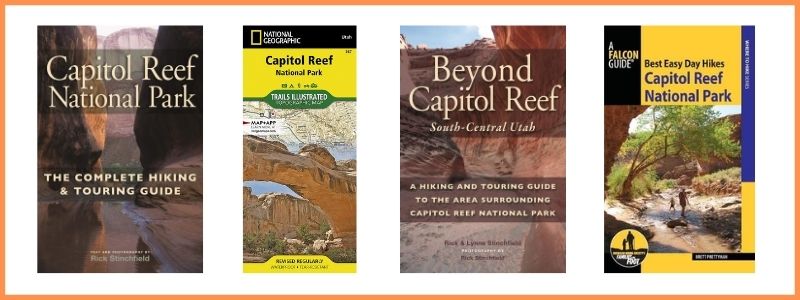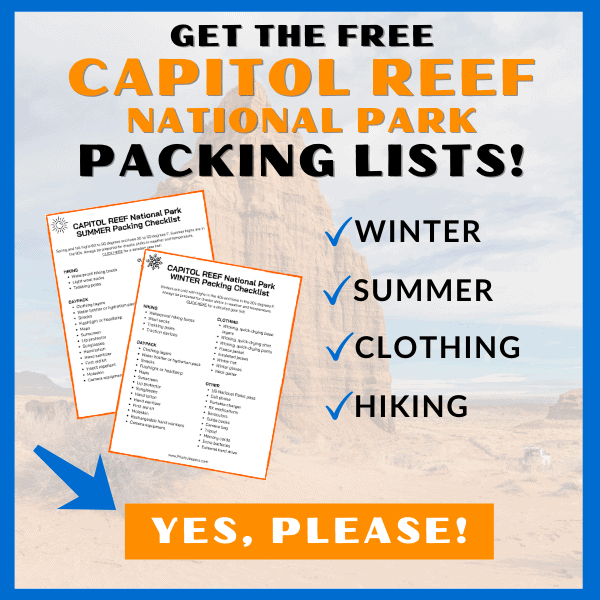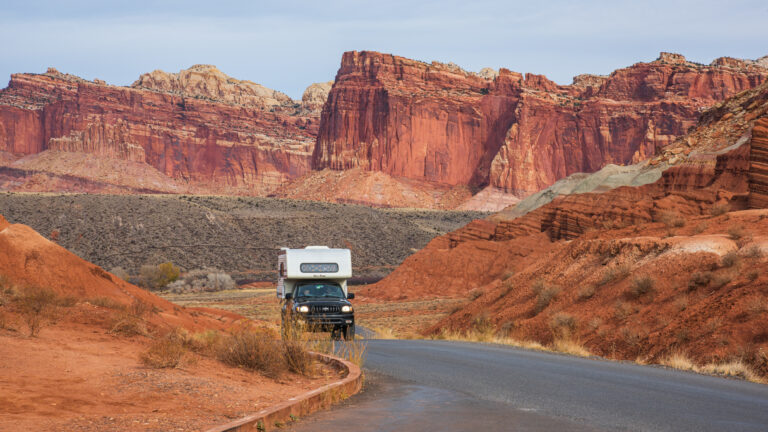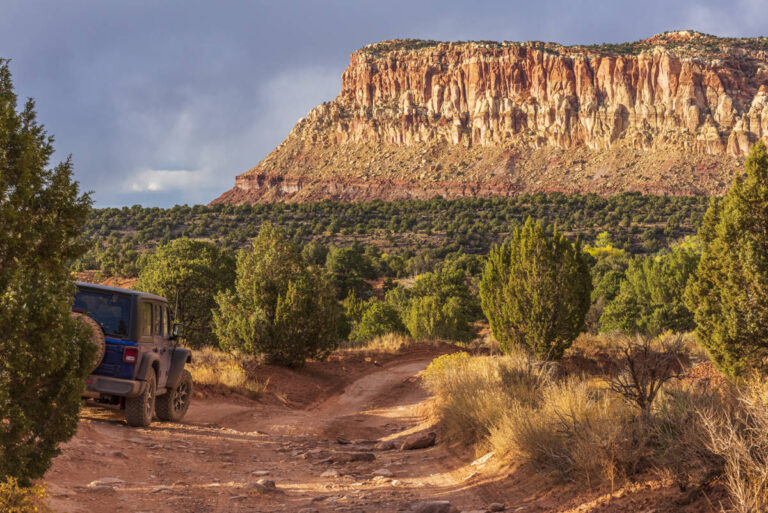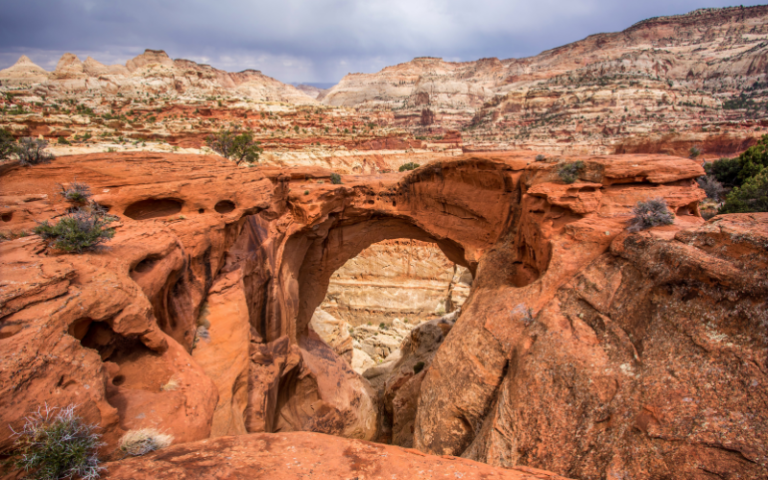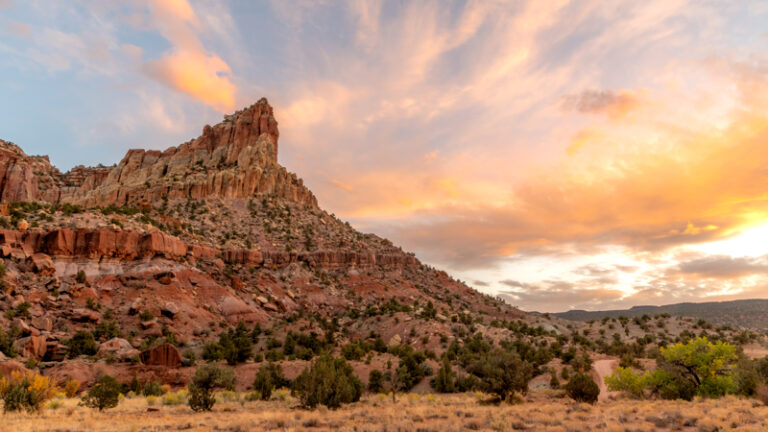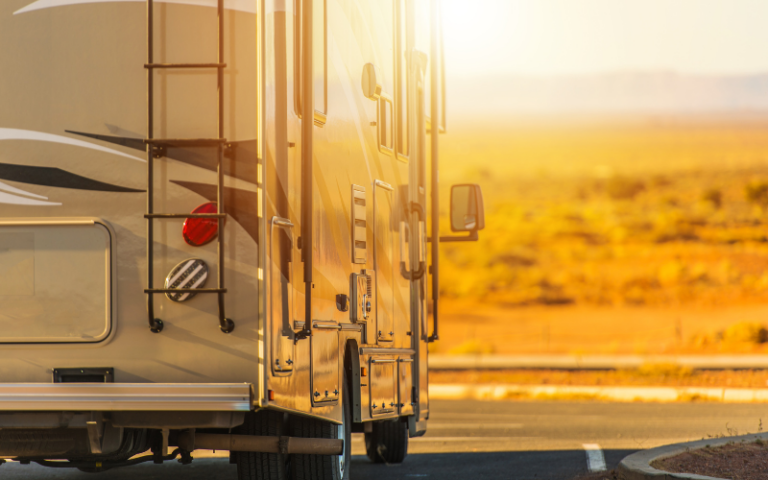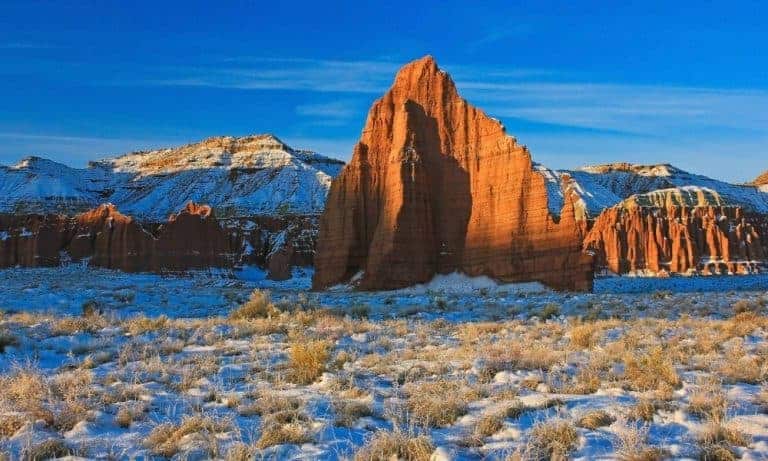Awesome Tips for Visiting Capitol Reef National Park
Here’s everything you need to know about visiting Capitol Reef National Park!
Use this Capitol Reef National Park guide to plan the most amazing vacation: things to do, what to pack, where to stay, and more!
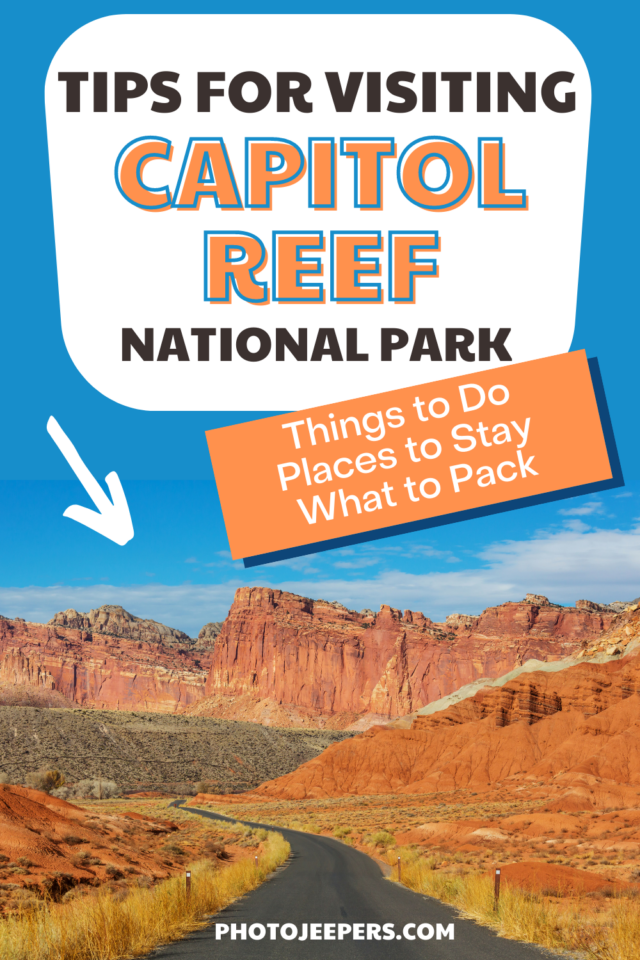
Capitol Reef is known for its stunning desert landscape. Visitors can enjoy hiking, backpacking, off-roading, photography, and camping.
We have written this ultimate guide to Capitol Reef National Park that includes everything you need to know to visit any time of year!
Check out these Capitol Reef itineraries based on the amount of time you have to visit the park:
- Capitol Reef National Park in One Day
- Two days in Capitol Reef National Park
- Three days in Capitol Reef National Park
This site contains affiliate links which means WE may receive commissions for purchases made through these links. We only provide links to products we actually use and/or wholeheartedly recommend! As an Amazon Associate, we earn from qualifying purchases. Read the full Disclosure Policy.
A Photo Tour of Capitol Reef National Park
Take a visual tour through Capitol Reef National Park to see the stunning landscape and wildlife you’ll find in the park!
Visiting Capitol Reef National Park: The Basics
Located in south-central Utah, the Capitol Reef National Park landscape is filled with cliffs, canyons, domes, and bridges. The area includes a geologic “wrinkle” on the earth called the Waterpocket Fold that extends almost 100 miles.
Best Time to Visit Capitol Reef National Park
Due to its location, the Capitol Reef area has large temperature fluctuations, sometimes up to 40 degrees in a single day!
The best time to visit Capitol Reef National Park is during the most temperate seasons in the spring (April through May) and fall (mid-September through October). The spring and fall daytime highs average 60º to 80ºF and lows average 30º to 50ºF .
The busy season is also in the spring (March to June) and in the fall (September to October). Here are a few tips to help you avoid the crowds:
- Visit during the week when it is less busy.
- Be flexible about the activities you want to do – if the parking lot is full, try again later.
- Explore less visited areas of the park, like the North and South districts. Keep in mind these areas are remote and require an appropriate vehicle.
- Hike early in the morning or late in the day.
Capitol Reef Operating Hours
The Capitol Reef park and campgrounds are open 24 hours a day, 365 days a year. The Visitor Center is open daily except for major holidays. Check the website for the most updated hours.
The Gifford House Store and Museum is usually open from March 14 (Pi Day) to the end of October.
Capitol Reef National Park Fees
There are a variety of passes available to visit Capitol Reef. Check the website for the most current fee prices and information.
BUDGET TRAVEL TIP: If you’ll also be visiting Bryce Canyon National Park, or other Utah parks, we recommend getting the US National Park pass. (Did you know when you buy the National Parks Pass from REI, they donate 10% to the National Park Foundation?)
Capitol Reef National Park Weather
It’s all about the weather when deciding the best time of year to plan a vacation. Do your research to know what the Capitol Reef National Park weather will be at various times of year so you can decide which season and month is best for you to plan your vacation to this stunning park!
- Capitol Reef National Park in the Spring
- Capitol Reef National Park in the Summer
- Capitol Reef National Park in the Fall
- Capitol Reef National Park in the Winter
Capitol Reef National Park Pets Policy
Pets are welcome to visit Capitol Reef National Park. Please follow the guidlines:
- Bag your pet’s waste (and dispose of properly)
- Always leash your pet (leashes 6 feet)
- Respect wildlife
- Know where you can go
Pets are allowed on leash (6 feet or shorter) in the developed areas of the park:
- Trail from the visitor center to the Fruita Campground
- Fremont River Trail from the campground to the south end of Hattie’s Field
- Unfenced and/or unlocked Capitol Reef orchards
- Chesnut and Doc Inglesby picnic areas
- Capitol Reef campgrounds
- Within 50 feet of center line of roads (paved and dirt) open to public vehicle travel
- Parking areas open to public vehicle travel
Pets are not permitted on other hiking trails, in public buildings, or in the backcountry.
The Capitol Reef area desert can be deadly for pets. Car temperatures rise quickly in the sun, even on cool days. Your pet can easily die of heat exhaustion. If you are leaving a pet in a car, crack the windows as much as possible and leave water to drink. It can be dangerous or deadly to leave pets in the car when temperatures are above 68 degrees, even with the windows cracked.
Capitol Reef National Park Goods and Services
There is no lodging (except campgrounds), food (except treats at the Gifford House when it’s open in the summer), or gas services available in the park. However, you can find most services in the nearby town of Torrey, Utah 11 miles away. Groceries are available year-round in Loa, 27 miles away.
It’s always important to pack everything you’ll need for your day visit to Capitol Reef. There is water available at the Visitor Center.
The Visitor Center offers a bookstore that carries maps, books, posters, and postcards; restrooms; and free public WiFi.
Points of Interest at Capitol Reef
Here’s a list of our favorite points of interest you’ll find at Capitol Reef National Park:
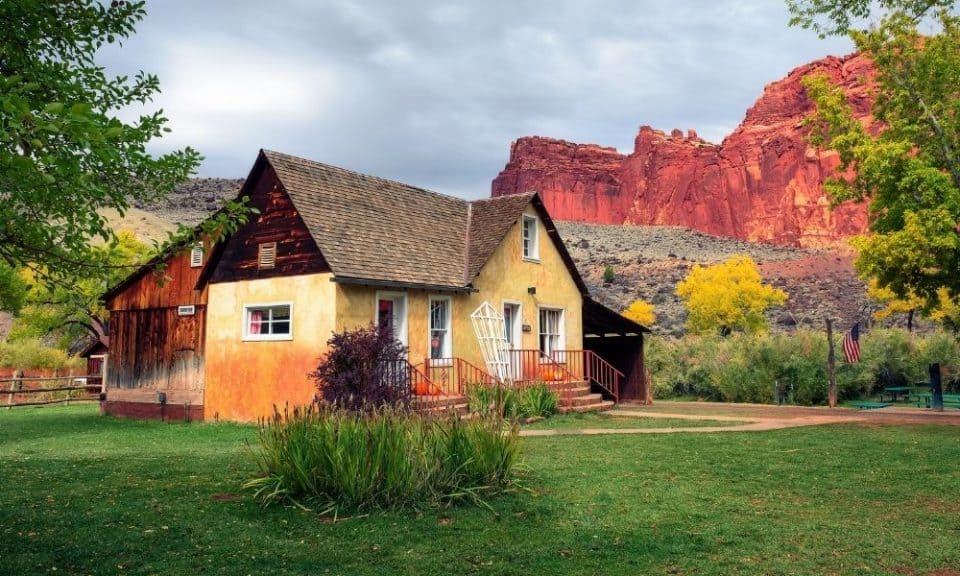
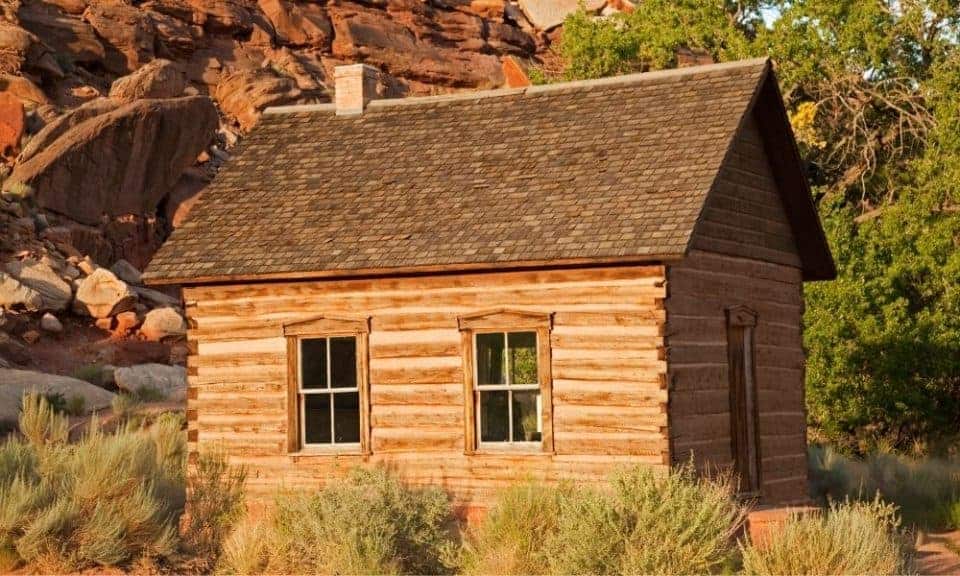
Fruita District of Capitol Reef
The heart of Capitol Reef National Park is called the Fruita District. You’ll see stunning landscape geology, historic structures and fruit orchards.
- Capitol Reef hikes – many start in Fruita
- Petroglyph Panel
- Gifford Homestead – amazing pies and other homemade treats!
- Fruita Schoolhouse
- Capitol Reef Orchards – have fun picking & eating fruit!
- Fruita Campground
- Capitol Reef Scenic Drive – starts in Fruita past the campground
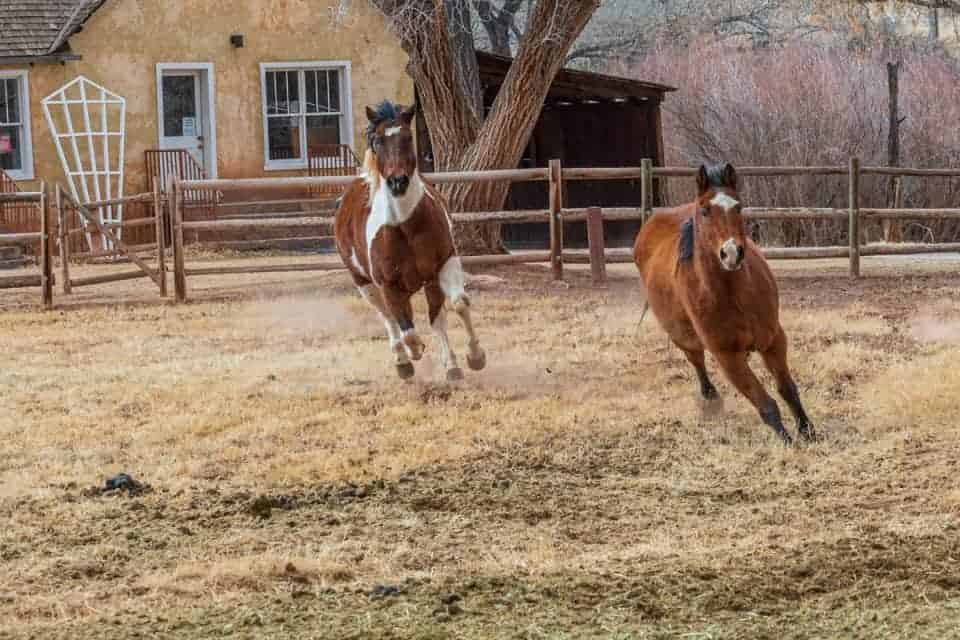
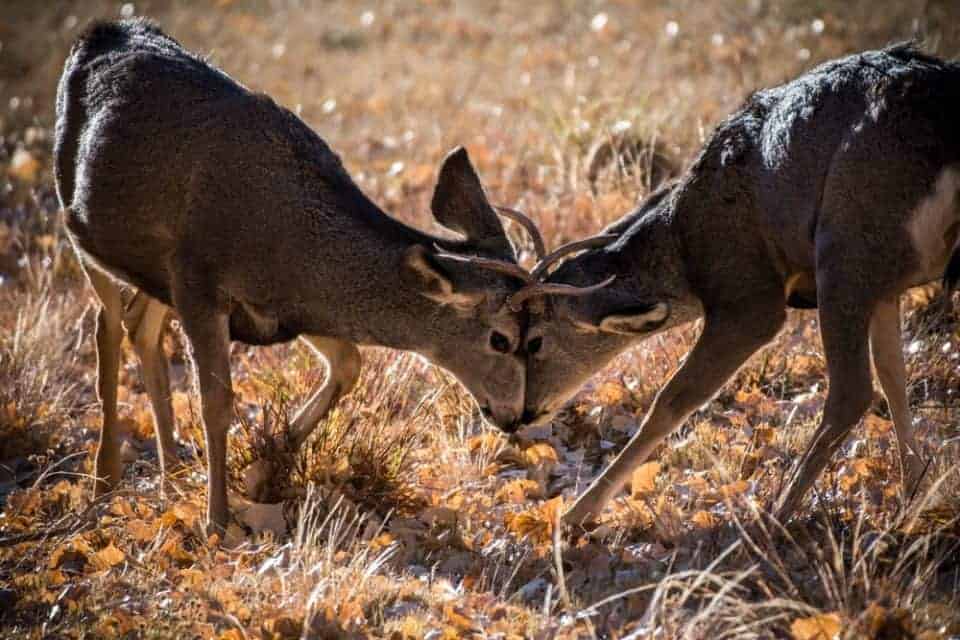
The Fruita district is the best place to photograph animals! The horses at the Gifford Barn are fun to watch. And deer frequent the orchards and picnic areas as well.
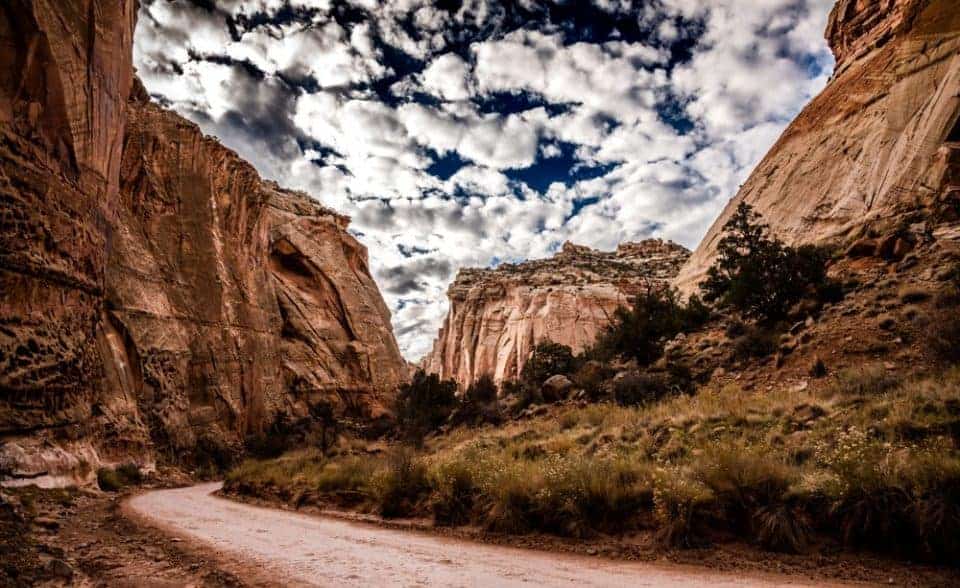
Capitol Reef Scenic Drive
The Capitol Reef scenic drive is 7.9 miles long. Exploring the Capitol Reef scenic drive, with the spur roads, usually takes 1.5 hours. The paved road is suitable for passenger vehicles. Since it’s not a loop road, you’ll drive back the way you came.
There are two dirt spur roads off the scenic drive: Grand Wash and Capitol Gorge. Passenger cars and RVs up to 27 feet in length are fine to drive the road. At the end of the Grand Wash and Capitol Gorge spur roads you’ll find a trailhead to two of the most amazing Capitol Reef hikes!
The Scenic Drive, Grand Wash, and Capitol Gorge roads can be closed due to snow, ice, mud, and flash floods.
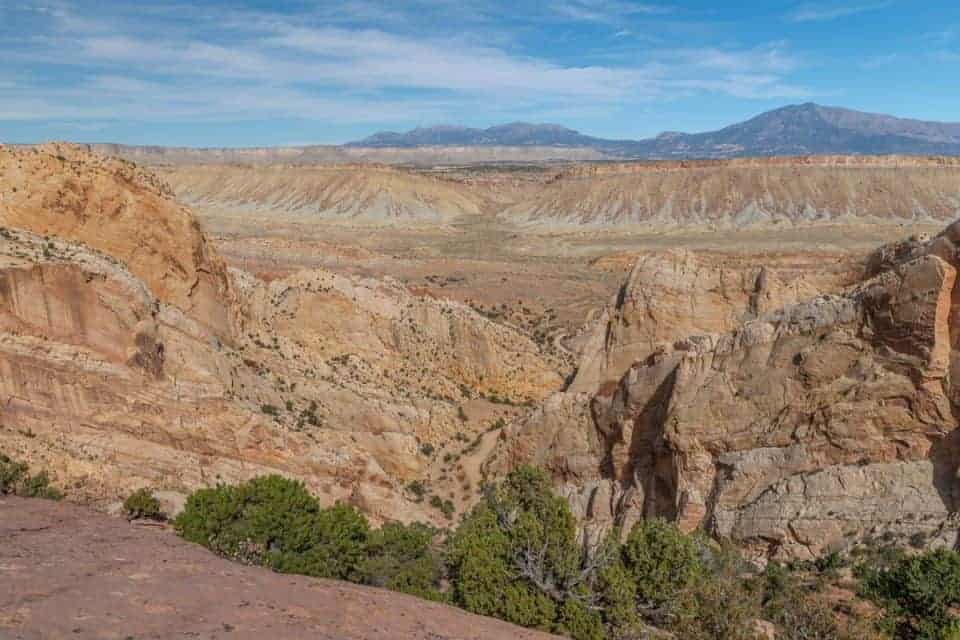
Capitol Reef Waterpocket District
The Waterpocket District is a remote and rugged area in Capitol Reef, but it’s so amazing! It’s open year-round and accessible by most passenger cars, pickups, and vans. Many of the roads are unpaved, and are often rough, sandy, and corrugated.
NOTE: Road conditions can change depending on recent weather conditions. Check the weather forecast before your visit. Spring and summer rains and winter snows can sometimes leave roads slick, muddy, washed out, and impassable even to the best high-clearance four-wheel drive vehicle.
We recommend the Loop-The-Fold Driving Tour to the southern part of the park. The loop is 124 miles and takes about 4-6 hours to complete.
- Start at the visitor center and follow Highway 24 east to the Notom-Bullfrog Road.
- Turn right on the Notom-Bullfrog Road and drive south to the Burr Trail Road junction.
- Turn right on the Burr Trail Road and drive west to Boulder, UT.
- Turn right (north) on Highway 12 to Torrey.
- Turn right (east) on Hwy 24 back to the visitor center.
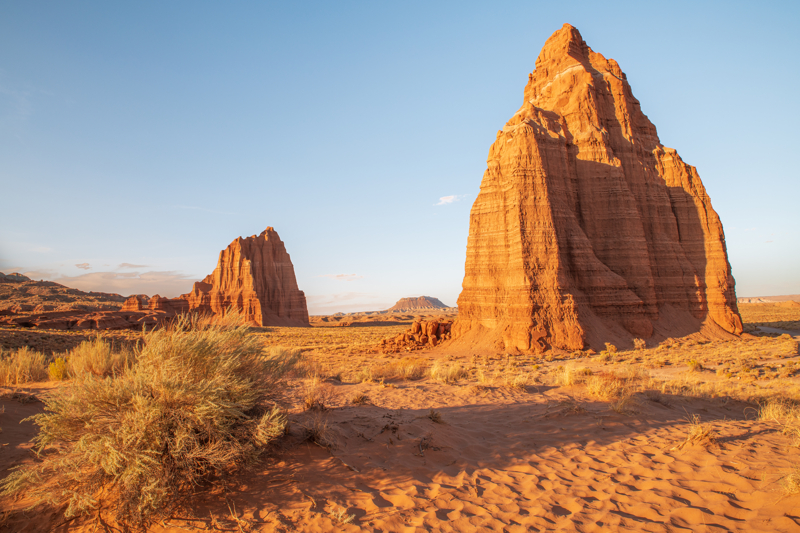
Cathedral Valley District
Like the Waterpocket District, the Cathedral Valley District is also a remote and rugged area on the north side of Capitol Reef National Park. For travelers to reach this area safely and comfortably, high clearance four-wheel-drive vehicles are required.
NOTE: Road conditions can change depending on recent weather conditions. Check the weather forecast before your visit.
The Cathedral Valley Driving Loop is about 57 miles and takes about 7 to 8 hours to complete. Another option is to drive from Highway 24 to Temple of Moon and Temple of the Sun, massive monoliths that rise from the desert floor, then return the way you came.
Some of the most interesting geological formations are found in Cathedral Valley, making it a perfect place for photography lovers.
Check out this private Capitol Reef Tour that take you through Cathedral Valley if you don’t have a 4×4 vehicle!
Things To Do at Capitol Reef
You’ll find a wide variety of things to do in Capitol Reef National Park:
Capitol Reef Ranger Led Programs
If you want to learn more about Capitol Reef National Park, we recommend you join a ranger for a program. Check the Visitor Center and Campground bulletin boards for locations, topics, and times.
- Geology Talk: year-round – discover the geologic story of Capitol Reef, 30 minutes
- Evening Program: late May to October- topics and start times vary, 1 hour
- Junior Ranger Program: year-round – request the activity book at the Visitor Center, complete the activities, and earn a badge!
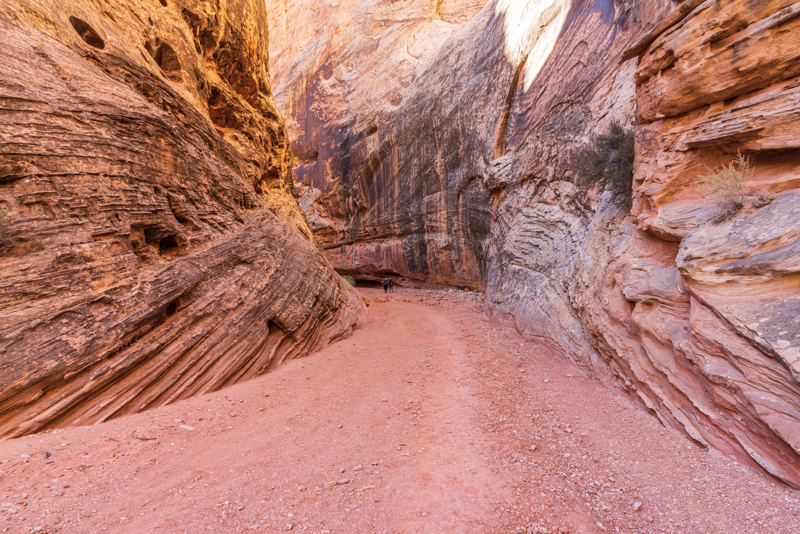
Hiking and Backpacking at Capitol Reef
Exploring the Capitol Reef hikes is one of the best ways to experience the park. The trailheads can be found in Fruita, along Utah Highway 24 and the Scenic Drive.
There are easy, moderate and strenuous hiking trails at Capitol Reef. Each trail is well-marked, so you never have to worry about getting lost along the way.
Backpacking trails at Capitol Reef include the Upper and Lower Muley Twist Canyons and Halls Creek. If you plan to overnight in the backcountry, you’ll need to get a free permit at the Visitor Center.
Use hydration packs or refillable water bottles to carry one gallon of water per person per day. Drinking water is available at the visitor center, picnic area, and campground. Do not drink untreated water. Do no drink water from the sprinklers.
NOTE: Flash floods are no joke!! They can be caused by run-off from intense, localized thunderstorms that drop a large amount of rain over a short period of time. Monsoon season at Capitol Reef is in July, August, and September, but flash floods can occur at any time of the year. Check the visitor center for current weather conditions, and look at the forecast before you hike in canyons!!
- Day Hike Checklist
- What to Bring on a Hike
- Photography Gear for Hiking
- Hiking Gear for Kids & Tips for Hiking with Kids
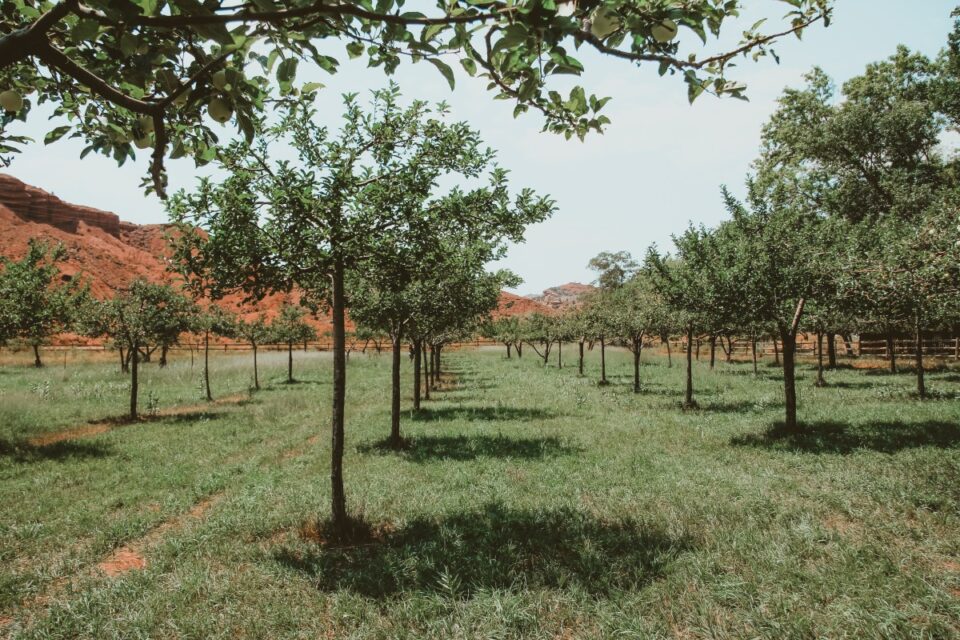
Pick Fruit in the Capitol Reef Orchards
One of the favorite activities at Capitol Reef is picking fruit from the orchard.
- Only harvest ripe fruit from orchards that have “U-Pick Fruit” signs.
- Signs will indicate which type of fruit is available for picking.
- Fruit taken from the orchards must be paid for using the self-pay station.
- Fenced orchard hours: 9:00 am to 5:00 pm.
- Unfenced orchard hours: Dawn to dusk.
- Don’t climb the historic trees – use provided hand pickers and ladders.
Capitol Reef orchards harvesting times (check the website for exact dates):
- Cherries: June – July
- Apricots: June – July
- Peaches: August – September
- Pears: August – September
- Apples: September – October
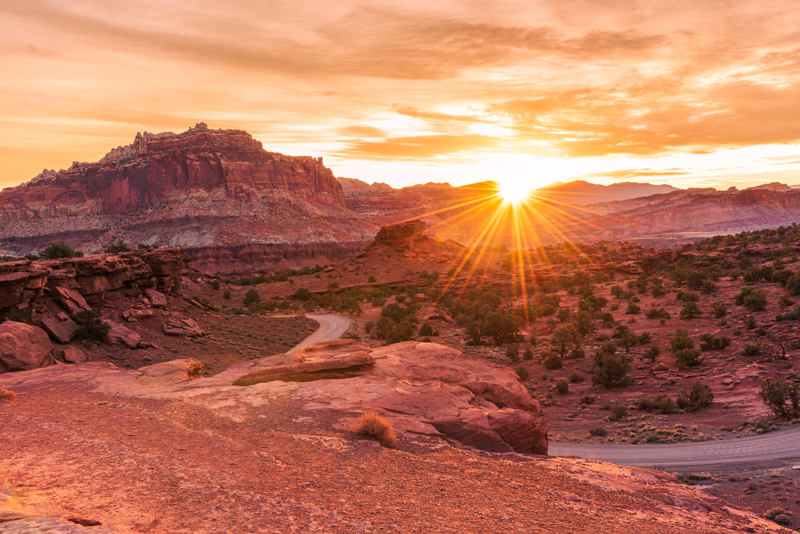
Photography at Capitol Reef
There are so many things to photograph here: an iconic barn with an incredible backdrop, quaint wooden pioneer structures, colorful rocks walls and deer roaming the fruit orchards!
Here’s a list of all the amazing Capitol Reef National Park photography locations:
- Panorama Point – sunrise and sunset
- Sunset Point – sunrise and sunset
- Chimney Rock
- Gifford Homestead
- Fruita Orchards – and the deer that frequent the area
- Fruita Barn – and the horses!
- Fruita Schoolhouse
- Fremont River and petroglyphs
- Hickman Bridge Hike
- Scenic Drive
- Cathedral Valley
- Burr Trail
CHECK OUT our Capitol Reef Photography Guide that details the best photo spots during the best light!
Biking at Capitol Reef
A great way to explore the park is biking at Capitol Reef. In the park, bikers must remember to stay on designated roads at all times. Please yield to pedestrians, dog walkers, be courteous, and keep speeds low.
The trail between the visitor center and Fruita Campground allows for bicycles (including e-bikes).
Bike touring routes include: Capitol Reef scenic drive and spur roads; Cathedral Valley Loop; South Draw Road; Burr Trail Loop. For overnight trips, you must camp in one of the three designated park campgrounds (Fruita, Cedar Mesa, or Cathedral Valley) or on adjacent BLM or USFS lands.
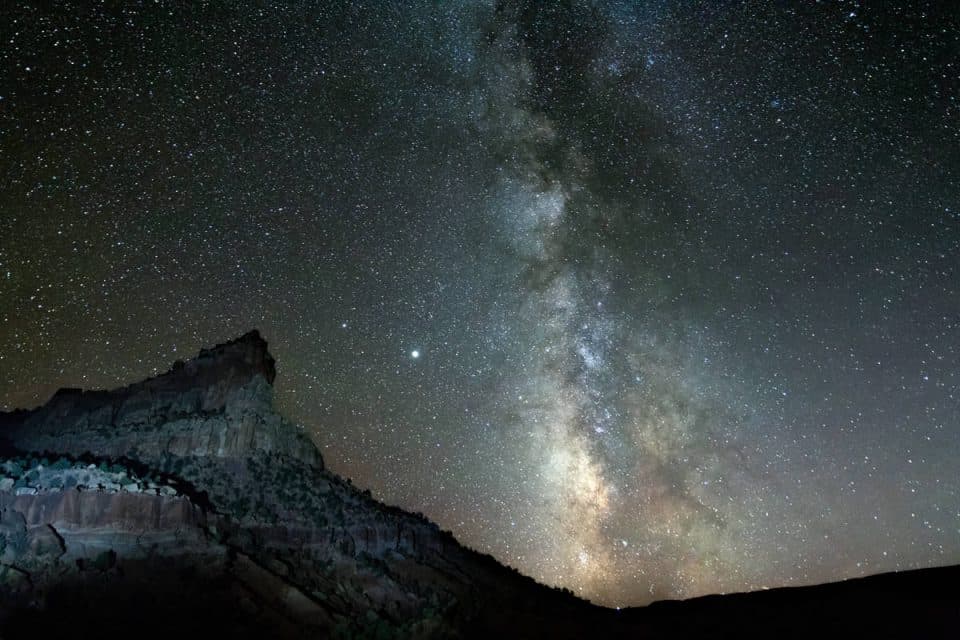
Stargazing at Capitol Reef
Capitol Reef is home to dark night skies, and has been designated an International Dark Sky Park. We recommend you take one night to “enjoy the park after dark”!
During the summer there might be ranger-led astronomy programs to enjoy Capitol Reef stargazing.
We’ve found it to be a fun place to photograph the milky way! Be sure to wear a headlamp with a red light to navigate in the dark.
Camping at Capitol Reef
Capitol Reef camping is an incredible way to maximize your stay. Various camping options will quench your thirst for a one-of-a-kind adventure.
- Fruita Campground
- Group Campsite at Fruita
- Primitive Campgrounds in Cathedral Valley and Cedar Mesa
- Backcountry Camping
- Camping options near Capitol Reef


